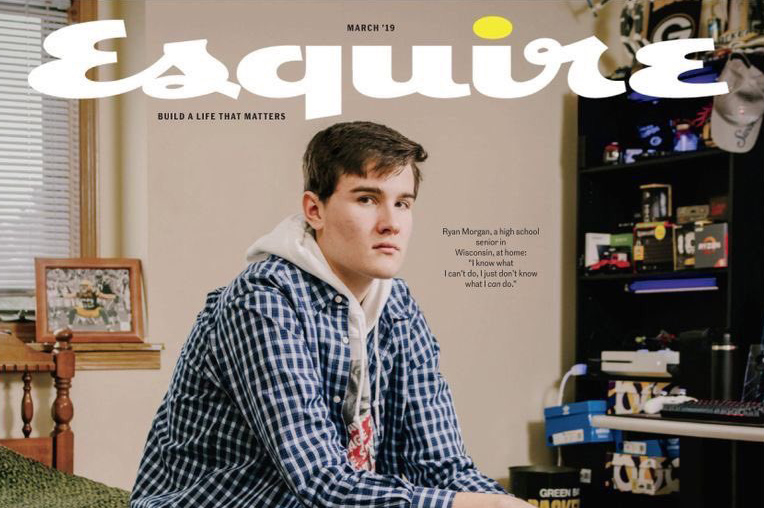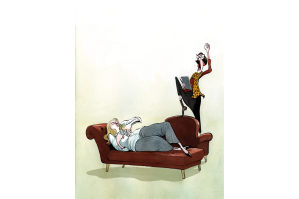You have to admire the inexhaustible capacity of the social justice left for taking offense. This week, the straight white male in the stocks is Jay Fielden, the editor-in-chief of Esquire. His sin? To put a white teenager called Ryan Morgan on the front of the March issue, accompanied by the line: ‘What it’s like to grow up white, middle class and male in the era of social media, school shootings, toxic masculinity and a divided country.’ Turns out, it’s a lot harder if you appear on the cover of Esquire.
I get what Esquire was going for here but ooooooooooooh boy talk about failing to read the room pic.twitter.com/OUzy3GJdI1
— Tyler McCall (@eiffeltyler) February 12, 2019
‘Really @esquire?’ tweeted Karamo Brown, a television presenter in Los Angeles. ‘“What’s it like growing up white, middle class and male…” How idiotic! It’s the same as it’s always been… full of privilege that women, people of color, lgbtq people & immigrants don’t have! I’m done.’ Another outraged tweeter, Leslie Mac, who runs ‘anti-racism boot camps’ in North Carolina, was even angrier: ‘Y’all – this Cover Story in @esquire is thee WHITEST SHIT I’ve come across all… well all week at least. I’m so fucking tired of press stories about poor white boys while marginalized people are actually dying because the current “era”.’
It goes without saying that both those commentators have blue ticks, Twitter’s imprimatur of approval. You’d have thought the blue-tick chorus would have learned its lesson after prematurely shaming Nick Sandmann, the 16-year-old Catholic schoolboy who was falsely accused of harassing a Native American protester at the Lincoln Memorial last month. But apparently this was not a ‘teachable moment’ for the Wokerati. After Esquire posted its March issue online, an author called Sarah Weinman – also the proud bearer a blue tick – compared its 17-year-old cover star to Dylann Roof, the white supremacist who shot and killed nine black worshippers at a church in 2015.
Jay Fieldon explained in an accompanying editorial that this article would be the first in a series about growing up in America and future installments would feature black, LGBTQ and female teens. But that did little to quell the anger of the left-wing mob. A common theme among the finger-wagging scolds was that Esquire should never have featured a white teen on its cover during Black History Month – even though that falls in February and Ryan Morgan is on the cover of the March issue.
‘I do not mind that there exists an article somewhere in the world about young white boys of privilege needing to relearn about masculinity,’ tweeted Abigail Collazo, a self-described feminist activist. ‘I do mind that it’s on the cover of @esquire during Black History Month.’
Zara Rahim, the former Communications Director of Vogue, tweeted: ‘Imagine this same ‘American Boy’ headline with someone who looked like Trayvon talking about what it’s like to have your mother sit you down to tell you how to stay alive in your own city during Black History Month. Just imagine. Shame on you @esquire.’
I know statistical data cannot hold a candle to the ‘lived experience’ of these oppressed television presenters and public relations executives – Zara Rahim was photographed standing next to Priyanka Chopra at the 2018 Met Gala, where tickets cost $30,000 per person – but the narrative that white teens have it easy compared to black teens in contemporary America isn’t as unassailable as they seem to imagine.
By almost every yardstick, racism is declining in the United States. According to Gallup, only four percent of Americans approved of black-white marriage in 1958; today, it’s 87 percent. In 1967, when miscegenation laws were repealed, three percent of all newlyweds were married to someone of a different race. By 2015, that number had risen to 17 percent, including 11 percent of white newlyweds. Next time an angry social justice activist tells you all white Americans are racist, point out that more than one in 10 white newlyweds have married a person of a different race.
Zara Rahim wasn’t the only liberal triggered by the Esquire cover to draw attention to police shootings of unarmed black teens, although she neglected to point out that the police officer who shot Trayvon Martin was a dual heritage Hispanic man. But the data about police shootings doesn’t support the Black Lives Matter story line. As the African-American Harvard economist Roland Fryer has painstakingly shown, blacks and Hispanics are no more likely to be shot by police officers than whites.
As for the claim that the 17-year-old Wisconsin native on the cover of Esquire is ‘privileged’ because he’s white, it’s worth bearing in mind that the victims of America’s opioid epidemic skew disproportionately white (which is why it’s known as ‘the White Death’) and African-American women have higher college attendance rates than white men, conditional on parental income. That’s one reason why 57 percent of black Americans now belong to the upper or middle class, according to the American Enterprise Institute, compared to just 38 percent in 1960.
When contrasting different countries, one way of measuring the level of racism is to ask whether people in that country would object if a person of another race moved in next door. By that metric, the US is among the least racist countries in the world. Less than five percent of Americans said they would object, compared to more than 50 percent of Pakistanis.
It’s also not true, as numerous angry blue ticks harrumphed, that teenage girls have a tougher time in Trump’s American than teenage boys. Women now comprise over 56 percent of students at American colleges and Ryan Morgan has a lower chance of being admitted to the University of Wisconsin than his female classmates.
The gender pay gap? Once you control for the fact that women are more interested in lower-paying jobs than men (only nine percent of US nurses are male), are more likely to take time out to start a family and have a higher preference for part-time work, the gap disappears. Gender studies professors will tell you different, of course, but a recent survey found that they are paid, on average, $15,000 a year more than male professors in STEM subjects.
Finally, it’s also a stretch to claim Morgan is particularly fortunate because he’s heterosexual. All the survey data suggests attitudes towards homosexuals in the US have never been more liberal. For instance, just 35 percent of Americans were in favor of gay marriage in 2001. By 2017, that number had increased to 62 percent. In Wisconsin, where LGBT people enjoy the same rights as heterosexuals, it’s 66 percent.
So please, could all these hashtag activists reel it in a bit? If they have no interest in the life of a white teenager growing up in middle America, fine, don’t read the story. But stop trying to shame Esquire’s editor-in-chief because he isn’t a fully-signed up member of the intersectionality cult. Better yet, spend some time outside of your ideological echo chamber. You might learn something.


















